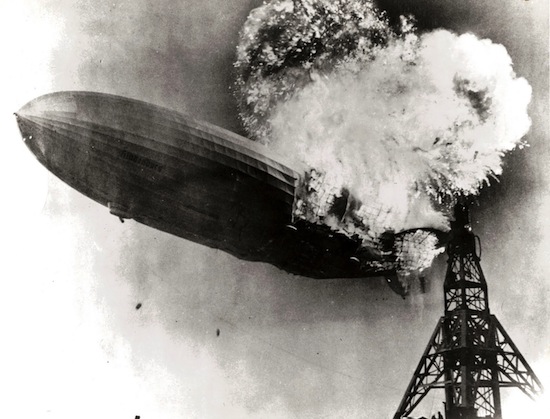What Really Sparked the Hindenburg Disaster?
Seventy-five years later, opinions still vary on what caused the airship to explode so suddenly
/https://tf-cmsv2-smithsonianmag-media.s3.amazonaws.com/filer/20120510023046Hindenburg_small.jpg)
On May 6, 1937—75 years ago this week—the Hindenburg airship was about the complete its 35th trip across the Atlantic, having departed from Frankfurt, Germany and nearly arrived at Lakehurst, New Jersey. Then, suddenly, after thousands of miles of uneventful travel, the great zeppelin caught fire while less than 300 feet from the ground. Within a minute of the first signs of trouble, the entire ship was incinerated, and the burning wreckage crashed to the ground. Thirty-five of the 97 people on board perished in the disaster.
Then the finger-pointing began. From the very start, observers disagreed about what exactly sparked the explosion and what caused it to burn so quickly. In the years since, scientists, engineers and others have used science to weigh in on the debate and attempt to solve the mystery of the Hindenburg.
During an era of tension between the United States and Germany’s new Nazi government, suspicious minds quickly alighted on the idea that a crew member or passenger had sabotaged the airship, intentionally starting a fire. However, nothing more than circumstantial evidence was ever put forth to support the idea. Realistic alternatives for the cause of the explosion include a buildup of static electricity, a bolt of lightning or a backfiring engine, but at this point it’s impossible to determine what exactly caused the spark.
A different question is what provided the fuel for the explosion—and this is where the science really gets interesting. Initially, observers assumed that some of the lighter-than-air hydrogen that kept the ship aloft somehow leaked from its enclosed cells, mixing with the oxygen in the air to create an incredibly flammable substance. Photographs taken right after the initial explosion show lines of fire along boundaries between the fuel cells, and crew members stationed in the stern reported seeing the actual cells burn, supporting the idea that leaking hydrogen caused the craft to explode so violently. Many have theorized that, during one of the sharp turns the ship took just before exploding, one of the bracing wires inside snapped, puncturing one of the cells.
Then, in 1996, retired NASA scientist Addison Bain, who had years of experience working with hydrogen, presented a new idea: the incendiary paint hypothesis. As part of his argument that hydrogen can be safely used for transportation and other purposes, Bain claimed that the fire was initially fueled by a special paint used on the zeppelin’s skin. The varnish compound included chemicals such iron oxide, which can be used as rocket fuel.
Bain also pointed out that the hydrogen inside the cells had been given a garlic scent, to help crew members detect a leak, but no one reported smelling garlic at the time of the explosion. He also said that a fire fueled by hydrogen would produce a blue flame, but the fire was a bright red. In his scenario, the mystery spark would have ignited the varnish rather than leaking hydrogen—meaning that a design flaw, rather than the inherent risks of hydrogen, had caused the disaster.
In 2005, a team of researchers led by A.J. Dessler, a physicist at Texas A&M, published a detailed study in which they attempted to determine whether the chemicals in the varnish could possibly account for the fire. Their answer: no way. Their calculations indicate that, if fueled by the paint alone, the airship would have taken roughly 40 hours to burn completely, rather than the 34 seconds it took for it to be consumed. In the lab, they burned replica pieces of the Hindenburg‘s outer covering, which confirmed their theoretical calculations—and indicated that the paint alone could not have fueled the fire.
So, more than 75 years later, we’re still not quite sure what to believe about the Hindenburg disaster. Can the use of hydrogen gas in transportation be safe? Or is a vehicle filled with flammable gas simply an accident waiting to happen? However it was caused, the terrible explosion had one long-lasting effect: It permanently put airship travel on the back burner.
Read about a new exhibit at the Smithsonian’s National Postal Museum about the Hindenburg and read an eyewitness account of the disaster from a grounds crew member.
/https://tf-cmsv2-smithsonianmag-media.s3.amazonaws.com/accounts/headshot/joseph-stromberg-240.jpg)

/https://tf-cmsv2-smithsonianmag-media.s3.amazonaws.com/accounts/headshot/joseph-stromberg-240.jpg)